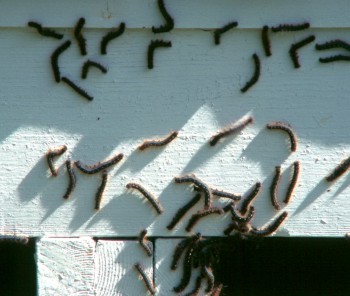
Invasion of the Worms!
| By Doug Collicutt | (Click links for more images.) |
|
As a Whiteshell Park cottager, I was pleased to hear that Manitoba Conservation WON'T be doing anything about the recent population explosion of forest tent caterpillars. At least the notion of aerial spraying with Bt has been squashed for 2001, so far. And so it should be. The Whiteshell and other provincial parks are, after all, natural areas and we should let nature take its course wherever and whenever its reasonable to do so.

Caterpillars swarming the cottage.
I experienced the full brunt of the tent caterpillar invasion in 2000. In our part of the south Whiteshell, the defoliation was complete. By mid-June there was barely a shred of leaf left on any of the deciduous trees and shrubs. Even the blueberry plants were stripped bare. It was rather eerie to walk about in a forest with no leaves, but with bright green grass and ferns covering the ground. Oh yeah, there were actually two kinds of plants that the caterpillars wouldn't eat, our native maples: the Manitoba maple (Acer negundo), a tree, and mountain or white maple (A. spicatum), a tall shrub. They nibbled on the white maple when all else was gone, but they wouldn't touch the Manitoba maple.
At its peak in June the mass movement of caterpillars was astounding; it was as though the grass around our cottage was alive. You couldn't walk anywhere without squooshing caterpillars. We kept a broom by both doors so we could sweep them out of the way as we left or entered. As a biologist I was quite enthralled by the whole process. It was one of the most amazing biological spectacles I've ever witnessed. OK, so it wasn't quite "herds of wildebeest streaming across the Serengeti", but it was still pretty cool. And at worst it was just a minor nuisance. It actually improved the early summer for me, because it kept so many people away!
The other fascinating aspect of the summer of 2000 was how quickly the forest trees rebounded. By mid July you couldn't tell that anything had happened, other than the cocoons everywhere. The trees and other shrubs had re-leafed fully. The infestation will certainly have effects on the other local wildlife, particularly other leaf eating insects, but these will be transient and it's nothing that all these species haven't had to deal with before. In another year or two the caterpillars will be gone again and people will have to find something else to complain about. Hey, remember "personal water craft" and 200 horsepower outboards!
Adult moths attracted to a light on the cottage.
Anyway, here's what Manitoba Conservation has to say about forest tent caterpillars. At Nature North we're happy to help "spread the biological word".
Carry on for Caterpillars, Caterpillars, Caterpillars!![]()
| You can help NatureNorth produce more great articles with a secure donation through PayPal. Our Google Adsense ads pay our server costs, but that's about it. To learn more follow this link: Support NatureNorth. Thank-you! | |
Return to: Summer Issue | NatureNorth Front page
